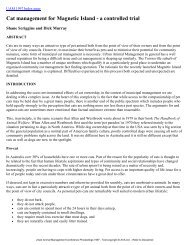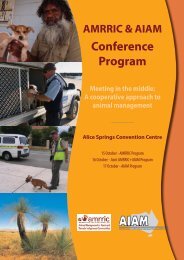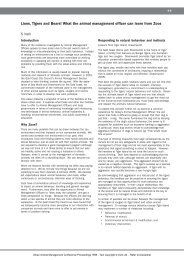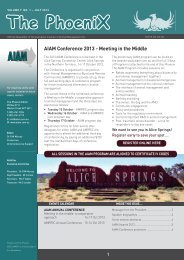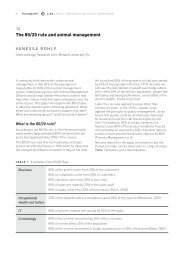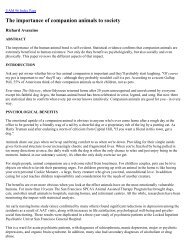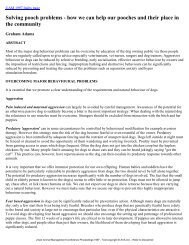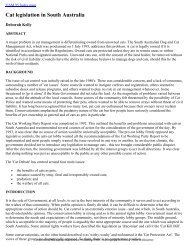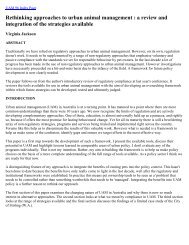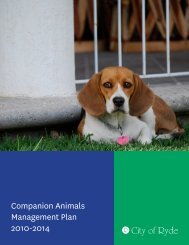Proceedings OF ThE - Australian Institute of Animal Management Inc
Proceedings OF ThE - Australian Institute of Animal Management Inc
Proceedings OF ThE - Australian Institute of Animal Management Inc
You also want an ePaper? Increase the reach of your titles
YUMPU automatically turns print PDFs into web optimized ePapers that Google loves.
56 <strong>Proceedings</strong> 2012<br />
AIAM Annual Conference on <strong>Animal</strong> <strong>Management</strong><br />
dingo proportion is <strong>of</strong>ten held as iconic and subject<br />
to conservation efforts, yet once pets or people are<br />
attacked or harassed these attitudes can be rapidly<br />
reversed. This conflict is compounded by a general<br />
lack <strong>of</strong> understanding about wild dog ecology and the<br />
effectiveness <strong>of</strong> management techniques in these<br />
environments.<br />
Impacts <strong>of</strong> free-ranging dogs are increasingly<br />
being felt by livestock producers on small holdings<br />
and residents <strong>of</strong> towns and suburbs throughout<br />
the more populated areas <strong>of</strong> eastern NSW and<br />
Queensland (e.g. Willey et al. 2008). Generally, the<br />
impacts on people, livestock and pets have not<br />
been quantified or analysed for patterns that might<br />
suggest mitigation strategies. Free-ranging dogs<br />
in these areas can also have substantial impacts<br />
on increasingly fragmented conservation estates<br />
around human communities and these too are<br />
mostly unquantified.<br />
The disease implications <strong>of</strong> free-ranging dogs where<br />
dogs and people interact are also unquantified.<br />
The contacts between free-ranging and restrained<br />
dogs are fundamentally important for predicting<br />
the epidemiology <strong>of</strong> diseases such as mange and<br />
rabies, yet there have been no studies to date <strong>of</strong><br />
this important interaction. A collaborative project<br />
addressing rabies preparedness is being undertaken<br />
between <strong>Animal</strong> <strong>Management</strong> in Rural and Remote<br />
Indigenous Communities (AMRRIC), University <strong>of</strong><br />
New England, University <strong>of</strong> Sydney and the authors.<br />
In various forums, bodies such as AMRRIC and local<br />
governments throughout Australia have consistently<br />
identified the need to improve our understanding <strong>of</strong><br />
peri-urban free-ranging dog ecology and behaviour<br />
so that tools, strategies and policies can be<br />
developed for their management. This information<br />
is required to assist in planning and coordinating<br />
control activities and raise the awareness and<br />
capacity <strong>of</strong> communities to deal with the issue.<br />
The Invasive <strong>Animal</strong>s Cooperative Research Centre,<br />
with councils from south east Queensland and north<br />
eastern NSW, is embarking on a project that will<br />
develop best practice management strategies and<br />
guidelines for implementation in peri-urban areas.<br />
Specifically, the project will study detailed daily<br />
movements, survival rates, and habitat use within<br />
participating local government areas. Stomachs<br />
and faeces will be collected and analysed for dietary<br />
composition and dependence on human provided<br />
subsidies. This will provide an indication <strong>of</strong> the<br />
relative importance <strong>of</strong> native and anthropogenic<br />
food sources, potential impact on native fauna and<br />
competition with other species, and likely foraging<br />
places. Tissue samples will be collected from freesettled<br />
environments. Uncertainty about status<br />
sometimes leads to inaction because responsibility<br />
is not clear.<br />
Ecology<br />
The ecology <strong>of</strong> free-ranging dogs in and around<br />
human communities is fertile ground for research.<br />
Only one study has been undertaken about the<br />
ecology <strong>of</strong> peri-urban wild dogs in eastern Australia<br />
(Allen 2006a; b) and Newsome (2011) investigated<br />
aspects <strong>of</strong> free-ranging dog ecology around a remote<br />
mining community in the Tanami Desert. Both these<br />
studies showed the importance <strong>of</strong> human resource<br />
subsidies to wild dog movement behaviour and diet.<br />
The movements <strong>of</strong> nine dingo-like free-ranging dogs<br />
in south east Queensland coastal communities over<br />
a few months indicated that home range sizes in<br />
urban settings were very much smaller (mean<br />
2.2 km 2 , 100% MCP estimate, Allen 2006a) than for<br />
free-ranging dogs in eastern agri-ecosystems<br />
(27km 2 ; ~10 –100 km 2 ; 42.5–124.3km 2 for Harden<br />
1985; Claridge et al. 2009; Robley et al. 2010<br />
respectively, all 100% MCP estimates). However,<br />
Allen’s (2006a) study was short term (7-45 days) with<br />
high frequency <strong>of</strong> GPS logging <strong>of</strong> locations and needs<br />
to be repeated over a longer time frame to ascertain<br />
seasonal differences in home range size and use.<br />
Newsome’s (2011) study could not have been in<br />
a more different environment to Allen’s (2006a).<br />
The mine community had a two refuse tips, the<br />
vast majority <strong>of</strong> food waste going into one <strong>of</strong> which<br />
However, Newsome (2011) found that home range<br />
size for dingoes wholly associated with the mine<br />
community was about 40 times smaller (10km 2 ,<br />
85% Kernel estimate) than dingoes that lived away<br />
from the mine, which supported Allen’s findings.<br />
The small home range sizes are likely the product<br />
<strong>of</strong> purposeful and accidental anthropogenic food<br />
subsidies (Newsome 2011). Although Allen and Leung<br />
(2012) briefly report the diets <strong>of</strong> peri-urban dogs<br />
in their broader examination <strong>of</strong> free-ranging dog<br />
diets, the importance <strong>of</strong> highly digestible domestic<br />
dog food and refuse to peri-urban dogs and its<br />
influence on their movements is unknown. One<br />
could reasonably expect on the basis <strong>of</strong> Newsome<br />
(2011) that sources <strong>of</strong> regular subsidy would be more<br />
visited by free-ranging dogs, and that these are likely<br />
foci for aggressive and other interactions with pets<br />
and children.<br />
Knowledge gaps and research<br />
Free-ranging dog management in peri-urban<br />
settings is <strong>of</strong>ten contentious and difficult to<br />
implement given the variety <strong>of</strong> stakeholders with<br />
wide-ranging and <strong>of</strong>ten conflicting ideologies. The



